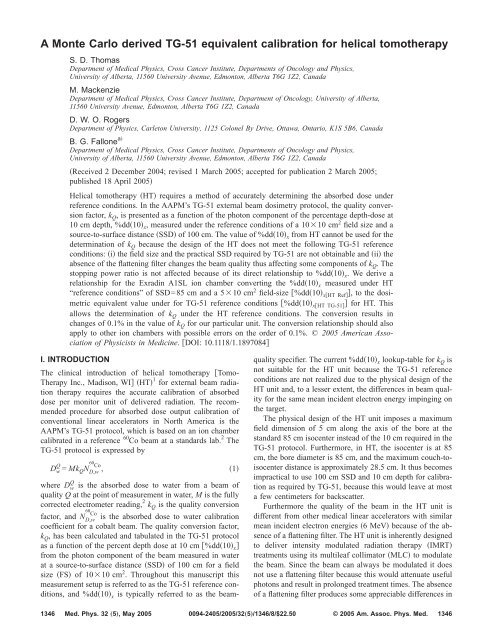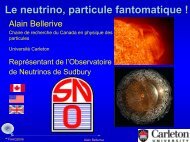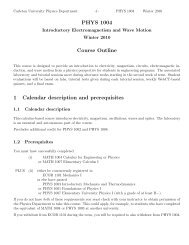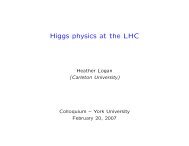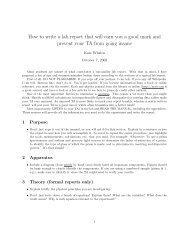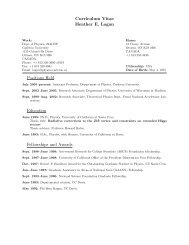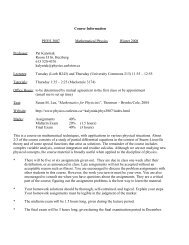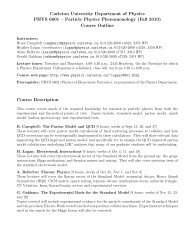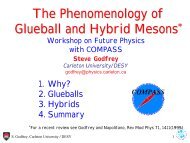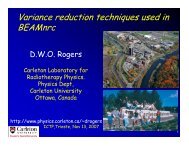A Monte Carlo derived TG-51 equivalent calibration for helical ...
A Monte Carlo derived TG-51 equivalent calibration for helical ...
A Monte Carlo derived TG-51 equivalent calibration for helical ...
You also want an ePaper? Increase the reach of your titles
YUMPU automatically turns print PDFs into web optimized ePapers that Google loves.
A <strong>Monte</strong> <strong>Carlo</strong> <strong>derived</strong> <strong>TG</strong>-<strong>51</strong> <strong>equivalent</strong> <strong>calibration</strong> <strong>for</strong> <strong>helical</strong> tomotherapy<br />
S. D. Thomas<br />
Department of Medical Physics, Cross Cancer Institute, Departments of Oncology and Physics,<br />
University of Alberta, 11560 University Avenue, Edmonton, Alberta T6G 1Z2, Canada<br />
M. Mackenzie<br />
Department of Medical Physics, Cross Cancer Institute, Department of Oncology, University of Alberta,<br />
11560 University Avenue, Edmonton, Alberta T6G 1Z2, Canada<br />
D. W. O. Rogers<br />
Department of Physics, Carleton University, 1125 Colonel By Drive, Ottawa, Ontario, K1S 5B6, Canada<br />
B. G. Fallone a<br />
Department of Medical Physics, Cross Cancer Institute, Departments of Oncology and Physics,<br />
University of Alberta, 11560 University Avenue, Edmonton, Alberta T6G 1Z2, Canada<br />
Received 2 December 2004; revised 1 March 2005; accepted <strong>for</strong> publication 2 March 2005;<br />
published 18 April 2005<br />
Helical tomotherapy HT requires a method of accurately determining the absorbed dose under<br />
reference conditions. In the AAPM’s <strong>TG</strong>-<strong>51</strong> external beam dosimetry protocol, the quality conversion<br />
factor, k Q , is presented as a function of the photon component of the percentage depth-dose at<br />
10 cm depth, %dd10 x , measured under the reference conditions of a 1010 cm 2 field size and a<br />
source-to-surface distance SSD of 100 cm. The value of %dd10 x from HT cannot be used <strong>for</strong> the<br />
determination of k Q because the design of the HT does not meet the following <strong>TG</strong>-<strong>51</strong> reference<br />
conditions: i the field size and the practical SSD required by <strong>TG</strong>-<strong>51</strong> are not obtainable and ii the<br />
absence of the flattening filter changes the beam quality thus affecting some components of k Q . The<br />
stopping power ratio is not affected because of its direct relationship to %dd10 x . We derive a<br />
relationship <strong>for</strong> the Exradin A1SL ion chamber converting the %dd10 x measured under HT<br />
“reference conditions” of SSD=85 cm and a <strong>51</strong>0 cm 2 field-size %dd10 xHT Ref , to the dosimetric<br />
<strong>equivalent</strong> value under <strong>for</strong> <strong>TG</strong>-<strong>51</strong> reference conditions %dd10 xHT <strong>TG</strong>-<strong>51</strong> <strong>for</strong> HT. This<br />
allows the determination of k Q under the HT reference conditions. The conversion results in<br />
changes of 0.1% in the value of k Q <strong>for</strong> our particular unit. The conversion relationship should also<br />
apply to other ion chambers with possible errors on the order of 0.1%. © 2005 American Association<br />
of Physicists in Medicine. DOI: 10.1118/1.1897084<br />
I. INTRODUCTION<br />
The clinical introduction of <strong>helical</strong> tomotherapy Tomo-<br />
Therapy Inc., Madison, WI HT 1 <strong>for</strong> external beam radiation<br />
therapy requires the accurate <strong>calibration</strong> of absorbed<br />
dose per monitor unit of delivered radiation. The recommended<br />
procedure <strong>for</strong> absorbed dose output <strong>calibration</strong> of<br />
conventional linear accelerators in North America is the<br />
AAPM’s <strong>TG</strong>-<strong>51</strong> protocol, which is based on an ion chamber<br />
calibrated in a reference 60 Co beam at a standards lab. 2 The<br />
<strong>TG</strong>-<strong>51</strong> protocol is expressed by<br />
D Q 60<br />
w = Mk Q N Co<br />
D,w<br />
, 1<br />
where D Q w is the absorbed dose to water from a beam of<br />
quality Q at the point of measurement in water, M is the fully<br />
corrected electrometer reading, 2 k Q is the quality conversion<br />
60<br />
factor, and N Co<br />
D,w<br />
is the absorbed dose to water <strong>calibration</strong><br />
coefficient <strong>for</strong> a cobalt beam. The quality conversion factor,<br />
k Q , has been calculated and tabulated in the <strong>TG</strong>-<strong>51</strong> protocol<br />
as a function of the percent depth dose at 10 cm %dd10 x <br />
from the photon component of the beam measured in water<br />
at a source-to-surface distance SSD of 100 cm <strong>for</strong> a field<br />
size FS of 1010 cm 2 . Throughout this manuscript this<br />
measurement setup is referred to as the <strong>TG</strong>-<strong>51</strong> reference conditions,<br />
and %dd10 x is typically referred to as the beamquality<br />
specifier. The current %dd10 x lookup-table <strong>for</strong> k Q is<br />
not suitable <strong>for</strong> the HT unit because the <strong>TG</strong>-<strong>51</strong> reference<br />
conditions are not realized due to the physical design of the<br />
HT unit and, to a lesser extent, the differences in beam quality<br />
<strong>for</strong> the same mean incident electron energy impinging on<br />
the target.<br />
The physical design of the HT unit imposes a maximum<br />
field dimension of 5 cm along the axis of the bore at the<br />
standard 85 cm isocenter instead of the 10 cm required in the<br />
<strong>TG</strong>-<strong>51</strong> protocol. Furthermore, in HT, the isocenter is at 85<br />
cm, the bore diameter is 85 cm, and the maximum couch-toisocenter<br />
distance is approximately 28.5 cm. It thus becomes<br />
impractical to use 100 cm SSD and 10 cm depth <strong>for</strong> <strong>calibration</strong><br />
as required by <strong>TG</strong>-<strong>51</strong>, because this would leave at most<br />
a few centimeters <strong>for</strong> backscatter.<br />
Furthermore the quality of the beam in the HT unit is<br />
different from other medical linear accelerators with similar<br />
mean incident electron energies 6 MeV because of the absence<br />
of a flattening filter. The HT unit is inherently designed<br />
to deliver intensity modulated radiation therapy IMRT<br />
treatments using its multileaf collimator MLC to modulate<br />
the beam. Since the beam can always be modulated it does<br />
not use a flattening filter because this would attenuate useful<br />
photons and result in prolonged treatment times. The absence<br />
of a flattening filter produces some appreciable differences in<br />
1346 Med. Phys. 32 „5…, May 2005 0094-2405/2005/32„5…/1346/8/$22.50 © 2005 Am. Assoc. Phys. Med. 1346
1347 Thomas et al.: <strong>TG</strong>-<strong>51</strong> <strong>calibration</strong> <strong>for</strong> tomotherapy 1347<br />
the beam’s photon spectrum compared to conventional medical<br />
linear accelerators that employ flattening filters. The ion<br />
chamber measured transverse beam profile from the HT unit<br />
is significantly different from the cross-plane beam profile<br />
from a conventional 6 MV medical linear accelerator Fig.<br />
1a. The “house” shaped HT profile is due to the unfiltered<br />
bremsstrahlung distribution. 3 The <strong>Monte</strong> <strong>Carlo</strong> calculated energy<br />
spectrum of the HT unit photon beam is quite different<br />
from our calculation of the Varian 2100EX Varian 21EX<br />
conventional 6 MV medical linear accelerator and comprises<br />
a larger proportion of low-energy photons Fig. 1b due to<br />
reduced beam hardening resulting from the absence of a flattening<br />
filter. The differences in spectrum and the difference<br />
in scatter from regions off the central axis result in a depthdose<br />
curve which differs from that of a conventional medical<br />
linear accelerator under the same measurement conditions. In<br />
this work, a new %dd10 x conversion function is determined<br />
<strong>for</strong> use with the <strong>TG</strong>-<strong>51</strong> protocol which accounts <strong>for</strong><br />
the differences in both the reference geometry and the beam<br />
characteristics of HT.<br />
II. METHODS AND MATERIALS<br />
A. Ion chamber<br />
We used an Exradin A1SL Standard Imaging, Middleton,<br />
WI waterproof ion chamber with 1.1 mm walls of C552<br />
air-<strong>equivalent</strong> plastic because its small volume 0.056 cm 3 <br />
minimizes volume averaging which could arise from the<br />
nonflat beam profile Fig. 1a. The Exradin A1SL A1SL<br />
ion chamber has a cavity diameter of 4.05 mm and a length<br />
of 4.4 mm. The central electrode of the ion chamber is also<br />
comprised of C552 air <strong>equivalent</strong> plastic.<br />
B. k Q<br />
The quality conversion factor, k Q , which converts a 60 Co<br />
absorbed dose <strong>calibration</strong> coefficient into one suitable <strong>for</strong> the<br />
HT unit’s beam is given by 4<br />
k QHT <strong>TG</strong>-<strong>51</strong> =<br />
L¯/ water air P wall P repl P cel HTSSD=85 cm,FS=5Ã10 cm 2 ,depth=10 cm<br />
L¯/ water air P wall P repl P cel 60 CoSSD=100 cm,FS=10Ã10 cm 2 ,depth=10 cm<br />
, 2<br />
where L¯/ water air is the ratio of mean restricted mass collision<br />
stopping power spr in water to that in air. P wall is a correction<br />
factor that accounts <strong>for</strong> the presence of the ion chamber<br />
wall. P repl is a correction <strong>for</strong> fluence and gradient perturbations<br />
due also to the presence of the ion chamber cavity in<br />
the radiation field. In practice, P repl <strong>for</strong> dose measurements in<br />
broad photon beams may be accounted <strong>for</strong> by using an effective<br />
point of measurement. The correction factor P repl is<br />
inherently contained in all of our calculations of k Q . Thus<br />
dose determination <strong>for</strong> the HT unit will not require a shift in<br />
the reference position after the initial measurement of<br />
%dd10 x . P cel is the correction accounting <strong>for</strong> the presence<br />
of the central electrode within the ion chamber. In the case of<br />
the A1SL, where the ion chamber central electrode is made<br />
of the same material as the ion chamber wall, P cel is accounted<br />
<strong>for</strong> within P wall . The k Q <strong>for</strong> the A1SL is not included<br />
in the <strong>TG</strong>-<strong>51</strong> document. We have thus calculated k Q <strong>for</strong> the<br />
A1SL under the <strong>TG</strong>-<strong>51</strong> reference conditions Fig. 2. The<br />
calculations <strong>for</strong> k Q were made in the same manner and using<br />
the same data sources that are used in <strong>TG</strong>-<strong>51</strong>. 4–9<br />
P wall was determined using 4<br />
P wall =<br />
L¯/ air<br />
water air<br />
L¯/ C552<br />
1<br />
,<br />
en / C552 air<br />
water + 1−L¯/ water <br />
3<br />
air<br />
where L¯/ C552 is the air-to-C552 ratio of mean restricted<br />
mass collision stopping powers, is the fraction of ionization<br />
arising from electrons originating in the ion chamber<br />
wall, and en / C552 water is the C552-to-water ratio of mean<br />
mass energy absorption coefficients.<br />
All values required in the determination of k Q were modeled<br />
<strong>for</strong> a 60 Co unit, a Varian 21EX 6 MV Varian, Palo Alto,<br />
CA medical linear accelerator as well as an HT unit Siemens<br />
accelerator, proprietary collimator/MLC at five different<br />
mean incident electron energies. In each case, the<br />
phase space file of the incident photon beam was determined<br />
using the BEAMnrc user code. 10,11 The Varian 21EX 6 MV<br />
medical linear accelerator was modeled to test the basic accuracy<br />
of the calculations and to ensure the congruence of<br />
our methods with those of <strong>TG</strong>-<strong>51</strong>. Starting from Eq. 2 the<br />
calculation of k Q <strong>for</strong> HT is based on<br />
k QHT <strong>TG</strong>-<strong>51</strong> =<br />
L¯/ water air P wall HT Calculated<br />
L¯/ water air P wall Varian 6 MV Calculated<br />
k Q<strong>TG</strong>-<strong>51</strong> %dd10x =66.6%.<br />
In Eq. 4, the ratio of our calculated L¯/ water air P wall is<br />
used to scale the <strong>TG</strong>-<strong>51</strong> k Q calculation of %dd10 x =66.6%<br />
<strong>for</strong> the Varian 21EX. This allows us to deal with minor discrepancies<br />
between our calculations and those of <strong>TG</strong>-<strong>51</strong> by<br />
using our results only as a scaling factor <strong>for</strong> the <strong>TG</strong>-<strong>51</strong> values.<br />
Equation 4 follows from Eq. 2 with the assumption<br />
that P replHT = P replVarian 6 MV . This assumption is largely<br />
true <strong>for</strong> the A1SL between the 4 and 6 MV nominal accel-<br />
4<br />
Medical Physics, Vol. 32, No. 5, May 2005
1348 Thomas et al.: <strong>TG</strong>-<strong>51</strong> <strong>calibration</strong> <strong>for</strong> tomotherapy 1348<br />
FIG. 2. Values of k Q <strong>for</strong> the Exradin A1SL ion chamber as a function of<br />
%dd10 x are shown. These values are <strong>for</strong> conventional medical linear accelerators<br />
with a %dd10 x measurement made using the standard <strong>TG</strong>-<strong>51</strong><br />
reference conditions of SSD=100 cm and a 10Ã10 cm 2 field defined at the<br />
surface distance.<br />
incident electron energy of the HT unit. A third-order polynomial<br />
is then fit between the values of %dd10 xHT <strong>TG</strong>-<strong>51</strong><br />
and %dd10 xHT Ref .<br />
FIG. 1.a Measured beam profiles normalized to the maximum absorbed<br />
dose <strong>for</strong> a HT open field at SSD=85 cm and the Varian 21EX in 40-cmwide<br />
cross plane at SSD=90 cm. Both profiles are taken at 10 cm depth.<br />
The differences in SSD in the graph are unimportant as this is meant only as<br />
a qualitative comparison. b Our <strong>Monte</strong> <strong>Carlo</strong> calculated energy spectra of<br />
the full phase space file <strong>for</strong> the HT 6.0 MeV mean incident electron energy<br />
and the Varian 21EX. Both are scored in air <strong>for</strong> <strong>51</strong>0 cm 2 field at 85 cm<br />
SSD. The fluence was normalized such that the total fluence within the<br />
spectrum is equal to 1.<br />
erator potentials 12 as the difference in P repl <strong>for</strong> a 4-mm-diam<br />
chamber between 4 and 6 MV nominal accelerator potentials<br />
is only 0.02%. 7 There are indications that P repl may change<br />
in very small IMRT beams, 13 but we further assume this is<br />
not an issue <strong>for</strong> the <strong>51</strong>0 cm 2 field used here. Thus the<br />
assumption of an invariant P repl will result in a possible<br />
maximum error of 0.02% in our values of k Q <strong>for</strong> HT. Using<br />
Eq. 4 instead of Eq. 2 corrects our data by 0.35% due to<br />
the above-listed reasons as well as the inclusion of the P repl<br />
correction which we have not calculated independently of<br />
Eq. 4. We determine k Q as a function of the calculated<br />
value of %dd10 x under our HT reference conditions of a<br />
<strong>51</strong>0 cm 2 field at 85 cm SSD %dd10 xHT Ref <strong>for</strong> different<br />
incident beam energies. The calculated values of k Q are<br />
used to look up the <strong>equivalent</strong> value of %dd10 xHT <strong>TG</strong>-<strong>51</strong><br />
i.e., the <strong>equivalent</strong> value <strong>for</strong> <strong>TG</strong>-<strong>51</strong> reference conditions that<br />
would give the same value of k Q <strong>for</strong> each simulated mean<br />
C. <strong>Monte</strong> <strong>Carlo</strong> calculations<br />
1. BEAM modeling parameters<br />
Modeling <strong>for</strong> all radiation sources was per<strong>for</strong>med using<br />
the BEAMNRC user code. 10 The HT unit was modeled <strong>for</strong><br />
mean incident electron energies of 6.25, 6.0, 5.75, 5.5, and<br />
5.25 MeV. The electron inputs <strong>for</strong> the HT models used a<br />
Gaussian electron energy spread with a full width at half<br />
maximum FWHM of 12%; this is the same FWHM as used<br />
<strong>for</strong> other Siemens machines. 14 The effect of beam focal spot<br />
size on %dd was investigated, but as with conventional linear<br />
accelerators, the HT %dd was found to be insensitive to<br />
focal spot size. 14 The sensitivity of sprs to focal spot size was<br />
also investigated and, as with %dd, were found to be insensitive.<br />
The incident electron spatial distribution used <strong>for</strong> the<br />
six bremsstrahlung beams was a radial Gaussian function<br />
with a FWHM of 1.41 mm; this FWHM is a typical<br />
value. 15–17 Phase space data <strong>for</strong> the HT unit were generated<br />
at 85 cm from the source <strong>for</strong> a FS of <strong>51</strong>0 cm 2 defined at<br />
the surface of the phantom. A Gaussian incident electron<br />
energy spread with mean energy of 6 MeV and a 3% FWHM<br />
was used <strong>for</strong> the Varian 21EX model. Phase space data <strong>for</strong><br />
the Varian 21EX were generated at both 100 cm <strong>for</strong> a 10<br />
10 cm 2 field and at 85 cm <strong>for</strong> a <strong>51</strong>0 cm 2 field. The latter<br />
scoring was done to investigate the effects of the reference<br />
conditions on the variables within k Q . Range rejection with<br />
an ESAVEIN value of 1.5 MeV was used everywhere except<br />
<strong>for</strong> the target where an ESAVEIN value of 0.7 MeV was<br />
used. 11 Selective bremsstrahlung splitting was also used <strong>for</strong><br />
variance reduction. 18 For the 60 Co unit, a point source was<br />
used with the 60 Co energy spectrum supplied with the EGS<br />
distribution. 19 The 60 Co unit phase space data were generated<br />
at 100 cm <strong>for</strong> a 1010 cm 2 field. In modeling the radiation<br />
Medical Physics, Vol. 32, No. 5, May 2005
1349 Thomas et al.: <strong>TG</strong>-<strong>51</strong> <strong>calibration</strong> <strong>for</strong> tomotherapy 1349<br />
sources, values of ECUT and PCUT were 0.7 and 0.01 MeV,<br />
respectively. 11 Although the HT energy spectrum has a<br />
higher contribution of low energy photons, the increase in<br />
the very low part of the spectrum i.e., below 100 keV is<br />
insignificant from that of a conventional 6 MeV linear accelerator<br />
and thus the EGSNRC codes are expected to provide<br />
accurate results.<br />
2. The value of %dd„10… x and beam profiles<br />
The value of %dd10 x and beam profile were modeled<br />
using the DOSXYZnrc user code. 20 The %dd10 x calculations<br />
were per<strong>for</strong>med in a 303030 cm 3 virtual water phantom.<br />
For HT, energy deposited was scored in 44<br />
1 mm 3 voxels 1 mm along the beam’s central axis, 4 mm<br />
in the directions orthogonal to the beam. For 60 Co and<br />
Varian 21EX, where the beam is much flatter, the cross section<br />
of the scoring voxels was 20201 mm 2 . Range rejection<br />
was employed with an ESAVIN value of 0.8 MeV.<br />
DOSXYZNRC’s nonuni<strong>for</strong>m padding around the scoring voxels<br />
was also used. ECUT and PCUT were set to 0.7 and 0.01<br />
MeV, respectively.<br />
All physical measurements were per<strong>for</strong>med at the facilities<br />
of the Cross Cancer Institute. The value of %dd10 x was<br />
measured using the A1SL in a water tank of 3030 cm 2<br />
cross section and 20 cm depth. A shift of 1.2 mm 0.6 r cav <br />
upstream was applied to the depth-dose curve. The absorbed<br />
dose was integrated over a 10 s period at each depth. An<br />
in-air measurement was taken simultaneously in order to correct<br />
<strong>for</strong> any minor output variation from the HT unit.<br />
Dose profiles were measured in a solid water phantom at<br />
a depth of 1.5 cm and SSD of 85 cm using Kodak EDR2<br />
film. Film densities were converted to dose using a sensitometric<br />
curve. Profile measurements were compared with the<br />
profiles calculated using the DOSXYZnrc code. In calculating<br />
the dose profiles, the energy deposited was scored in an array<br />
of 444 mm 3 voxels centered at 1.5 cm depth and<br />
aligned along both the long and short axes of the field. The<br />
dose profile along the long axis of a 540 cm 2 field was<br />
measured and calculated in order to tune the focal spot.<br />
3. Water-to-air spr<br />
The water-to-air spr <strong>for</strong> all seven photon beams modeled<br />
was calculated using the SPRRZnrc user code. 21–23 The spr<br />
values were calculated in a virtual cylindrical water phantom<br />
of 20 cm radius and 30 cm depth. The simulated beam dimensions<br />
were significantly smaller than 20 cm. A cylindrical<br />
scoring voxel of 1 cm radius and 0.5 cm thickness was<br />
centered at a depth of 10 cm to determine the spr values at<br />
that depth. ECUT and PCUT were set to 0.521 and 0.01<br />
MeV, respectively. 21<br />
4. Air-to-C552 spr<br />
The air-to-C552 spr was determined <strong>for</strong> the seven different<br />
photon beams using the SPRRZnrc user code. A virtual<br />
cylindrical phantom of 20 cm radius was used. Cylindrical<br />
slabs of C552 3 cm thick 60 Co beam and 5 cm thick HT<br />
FIG. 3.a The calculated percent depth dose curve of the 5.25 and 6.25<br />
MeV HT mean incident electron energy as compared to the measured percent<br />
depth dose. b The calculated absorbed dose profiles of the HT unit<br />
5.5 MV compared to the measured profiles of the HT unit. Measurements<br />
were made with Kodak EDR2 film. Lines are the measured data of their<br />
corresponding calculated values.<br />
and Varian 21EX beams were placed between 10- and 20-<br />
cm-thick cylindrical slabs of water. The photon beams were<br />
incident on the surface of the first, i.e., 10-cm-thick water<br />
slab. The cylindrical scoring voxel of 1 cm radius and 0.5 cm<br />
thickness was placed in C552 at a depth of 11.25 cm <strong>for</strong> the<br />
60 Co beam and 12.25 cm <strong>for</strong> the HT unit and the Varian<br />
21EX linear accelerator. This thickness of C552 was sufficient<br />
to ensure that the electrons <strong>for</strong> which the spr was determined<br />
were those originating in the C552. The 20 cm<br />
thickness of the second water slab following the C552 was<br />
used to allow <strong>for</strong> sufficient backscattered photons. The <br />
term in P wall refers to the fraction of ionization arising from<br />
electrons originating in the ion chamber wall. 4 Since the ionchamber<br />
wall is made of C552, we are required to use the<br />
C552 water phantom <strong>for</strong> these calculations.<br />
5. C552-to-water ratio of mean mass energy<br />
absorption coefficients<br />
In order to determine the ratio of mean mass energy absorption<br />
coefficients, the FLURZnrc user code 21 was used to<br />
determine photon fluence spectra in a cylindrical virtual water<br />
phantom of radius 20 cm and of thickness 22.5 cm. The<br />
Medical Physics, Vol. 32, No. 5, May 2005
1350 Thomas et al.: <strong>TG</strong>-<strong>51</strong> <strong>calibration</strong> <strong>for</strong> tomotherapy 1350<br />
TABLE I. A comparison of values required <strong>for</strong> the %dd conversion. For the statistical error calculations of k Q any<br />
error less than 0.0001 was rounded up to 0.0001. Error in the value of P wall or the <strong>TG</strong>-<strong>51</strong> value of k Q <strong>for</strong> the<br />
Varian 6 MV was not considered. The error in %dd10 xHT <strong>TG</strong>-<strong>51</strong> corresponds to the error in k Q .<br />
Mean incident<br />
electron energy MeV<br />
L¯/ water HT Calc<br />
air P wall Varian6 MV Calc<br />
k QHT <strong>TG</strong>-<strong>51</strong> %dd10 xHT Ref %dd10 xHT <strong>TG</strong>-<strong>51</strong><br />
5.25 1.00302 0.99812 58.8%3 59.8%+16/−6<br />
5.50 1.00252 0.99762 59.2%3 62.2%+7/−4<br />
5.75 1.00212 0.99722 59.8%3 63.0%+4/−5<br />
6.00 1.00172 0.99672 60.4%3 63.9%+4/−4<br />
6.25 1.00122 0.99632 60.8%3 64.6%+3/−3<br />
fluence was calculated in a cylinder of radius 2.4 cm and<br />
thickness 5 cm centered at a depth of 10 cm along the beam<br />
central axis. This large scoring voxel was chosen to minimize<br />
the statistical uncertainty of the energy fluence. The<br />
difference in the photon spectrum of this larger sampling<br />
volume to the sampling volume used in the spr calculations<br />
was found to affect the mean mass energy absorption coefficient<br />
by less than 0.003%. The photon fluence was binned<br />
into 0.1 MeV intervals <strong>for</strong> the linear accelerator and HT unit<br />
and 0.01 MeV intervals <strong>for</strong> the 60 Co unit. The photon fluence<br />
was then used to weight the individual values of mass energy<br />
absorption coefficients en / of the medium: 24<br />
en / medium = E max<br />
0 E•E en /E medium dE<br />
E<br />
, 5<br />
max 0 E•EdE<br />
where E is the photon fluence spectrum. In the case where<br />
National Institute of Standards and Technology NIST gave<br />
no direct mean mass energy absorption coefficient value <strong>for</strong><br />
a corresponding energy bin, the mass energy absorption coefficient<br />
was interpolated on a log-log scale. 24 The water and<br />
C552 mean mass energy absorption coefficient values calculated<br />
from Eq. 5 were then used to calculate the ratio of<br />
mean mass energy absorption coefficients.<br />
6. Determination of <br />
Values of <strong>for</strong> the Varian 21EX and the 60 Co unit were<br />
obtained from Lempert et al. 8 using the value of %dd10 x as<br />
the beam quality specifier. 4 The results of the Lempert et al.<br />
experiment are widely used in various dosimetry<br />
protocols. 2,7,9,25 In the case of the HT calculations, the value<br />
of %dd10 x would not be an appropriate beam quality specifier<br />
<strong>for</strong> due to both the difference in the measurement<br />
geometry and the beam quality. For the HT beams, the calculated<br />
value <strong>for</strong> the water-to-air spr was associated with<br />
what would be the <strong>TG</strong>-<strong>51</strong> <strong>equivalent</strong> value <strong>for</strong> %dd10 x . 5<br />
This <strong>equivalent</strong> %dd10 x value was then used to determine<br />
from the data of Lempert et al. as is done in <strong>TG</strong>-<strong>51</strong>. 4,8 The<br />
water-to-air spr was chosen as the beam quality transfer<br />
quantity since it represents the most rapidly changing parameter<br />
as a function of beam quality and it is relatively insensitive<br />
to geometric factors. 22<br />
III. RESULTS AND DISCUSSION<br />
A. <strong>Monte</strong> <strong>Carlo</strong> calculations<br />
1. The value of %dd„10… x and the beam profile<br />
Calculated values of %dd10 x <strong>for</strong> the 60 Co and the Varian<br />
21EX nominal 6 MV beam were 58.42% and 66.62%,<br />
respectively, whereas our measured values are 58.6% and<br />
66.7%, respectively. The calculated values of<br />
%dd10 xHT Ref were found to range between 58.83% and<br />
60.83% <strong>for</strong> the range of energies simulated see Fig. 3a<br />
and Table I. The statistical uncertainties in the last decimal<br />
place are given in brackets and represent 1 s.d. The measured<br />
value of %dd10 x <strong>for</strong> the HT unit at our center was 59.5%<br />
indicating a mean incident electron energy of 5.63 MeV Fig.<br />
3a. The value of %dd10 x <strong>for</strong> the Varian 21EX under the<br />
same reference conditions as our HT unit was calculated to<br />
be 62.72% and measured to be 63.0%. Thus the change in<br />
reference conditions leads to a change of 3.9% in the value<br />
of %dd10 x <strong>for</strong> the Varian 21EX calculation. The calculated<br />
%dd10 x value of our HT unit 6 MeV mean incident electron<br />
energy was 60.43%, and thus lower than what we calculated<br />
<strong>for</strong> Varian 21EX under the HT reference conditions.<br />
TABLE II. A comparison of our <strong>Monte</strong> <strong>Carlo</strong> calculated quantities and the corresponding <strong>TG</strong>-<strong>51</strong> <strong>equivalent</strong>s<br />
Refs. 5,9 to demonstrate the accuracy of our calculations. The values in parentheses are the statistical uncertainties<br />
of the last decimal place <strong>for</strong> the number that they append and represent 1 s.d., i.e., 1.13371 is<br />
<strong>equivalent</strong> to 1.1337±0.0001.<br />
Quantity<br />
60 Co unit 6 MV Varian 21 EX %dd10 x =66.6%<br />
Present <strong>TG</strong>-<strong>51</strong> %Diff Present <strong>TG</strong>-<strong>51</strong> %Diff<br />
water<br />
L¯/ air<br />
1.13371 1.1335 0.02% 1.120<strong>51</strong> 1.1212 0.06%<br />
air<br />
L¯/ C552<br />
1.00401 1.0048 0.08% 1.01741 1.0168 0.06%<br />
C552<br />
en / water 0.90031 0.9009 0.07% 0.90181 0.9016 0.02%<br />
Medical Physics, Vol. 32, No. 5, May 2005
13<strong>51</strong> Thomas et al.: <strong>TG</strong>-<strong>51</strong> <strong>calibration</strong> <strong>for</strong> tomotherapy 13<strong>51</strong><br />
FIG. 4. The photon spectra of the Varian 21EX 6 MV accelerator <strong>for</strong> two<br />
sets of reference conditions. These photon spectra are the same as are used<br />
<strong>for</strong> the mean mass energy absorption coefficient calculation described in sec<br />
II. The <strong>TG</strong>-<strong>51</strong> reference conditions result in a higher contribution of low<br />
energy photons scattered in from the larger initial primary beam. Here the<br />
photon fluence from the FLURZnrc has been normalized such that the sum of<br />
the total fluence equals 1.<br />
The difference in %dd10 xHT Ref obtained with a mean incident<br />
electron energy of 6 MeV to the %dd10 x obtained<br />
with the Varian 21EX under the HT reference conditions of<br />
85 cm SSD and <strong>51</strong>0 cm 2 field is 2.3%. In comparing the<br />
measured and calculated beam profiles of the <strong>51</strong>0 cm 2<br />
field, the calculated FWHM agrees with the measured<br />
FWHM to within 1.5 mm along the long axis and 0.05 mm<br />
along the short axis Fig. 3b. The calculated full width<br />
80% maximum agrees with the measured to within 2 mm of<br />
the long axis and 2.3 mm of the short axis Fig. 3b. Also<br />
shown is the long axis dose profile comparison <strong>for</strong> a<br />
5Ã40 cm 2 field Fig. 3b.<br />
2. Calculation accuracy<br />
The water-to-air spr’s <strong>for</strong> the 60 Co unit and the Varian<br />
21EX conventional medical linear accelerator were found to<br />
be 1.1337 1 and 1.1205 1, respectively; these are<br />
within 0.02% and 0.06% of the values used by <strong>TG</strong>-<strong>51</strong> in<br />
determination of k Q —Ref. 5 Table II. The air-to-C552 spr’s<br />
<strong>for</strong> the 60 Co and 6 MV Varian 21EX linear accelerator were<br />
found to be 1.00401 and 1.01741, respectively. These values<br />
are within 0.08% and 0.06% respectively, of the values<br />
used by <strong>TG</strong>-<strong>51</strong> in determination of k Q —Refs. 6, 9 Table II.<br />
The C552-to-water ratio of mean mass energy absorption<br />
coefficients <strong>for</strong> the 60 Co and 6 MV linear accelerator were<br />
found to be 0.9003 1 and 0.9018 1, respectively. The<br />
calculated numbers agree to within 0.07% <strong>for</strong> 60 Co and<br />
0.02% <strong>for</strong> the Varian 21EX with the values used in calculating<br />
k Q <strong>for</strong> <strong>TG</strong>-<strong>51</strong>. 9 Our calculated values used in the definition<br />
of the wall correction factor given in Eq. 3 yield a<br />
value of P wall <strong>for</strong> the A1SL of 0.9796 in a 60 Co beam and of<br />
0.9829 <strong>for</strong> the Varian 21EX. Our P wall values agree to within<br />
0.12% <strong>for</strong> the 60 Co unit and 0.01% <strong>for</strong> the Varian 21EX to<br />
P wall generated using the <strong>TG</strong>-<strong>51</strong> data 5,9 Table II. It should<br />
be noted that the air-to-C552 spr and the C552-to-water ratio<br />
of mean mass energy absorption coefficients <strong>for</strong> 60 Co agree<br />
to within 0.01% of more recent calculations 26,27 although our<br />
discrepancies with the corresponding <strong>TG</strong>-<strong>51</strong> values are<br />
slightly larger.<br />
3. Effect of change in reference conditions<br />
In this section, we determine the effect of changing the<br />
reference conditions on the dosimetric quantities <strong>for</strong> the<br />
Varian 21EX. This was done to determine what portion of<br />
the change in k Q is due to the difference in measurement<br />
setup. To accomplish this, we compare the values of the<br />
water-to-air spr, air-to-C552 spr, as well as the C552-towater<br />
ratio of mean mass energy absorption coefficients calculated<br />
<strong>for</strong> both the HT reference conditions and the <strong>TG</strong>-<strong>51</strong><br />
reference conditions. The water-to-air spr calculation using<br />
the Varian 21EX phase space data generated under HT reference<br />
conditions <strong>51</strong>0 cm 2 field at an 85 cm SSD yielded<br />
a value of 1.11971. This value was 0.07% lower than our<br />
calculation <strong>for</strong> the same linear accelerator under <strong>TG</strong>-<strong>51</strong> reference<br />
conditions. The decrease in spr indicates a slightly<br />
higher mean energy beam under the the HT reference conditions.<br />
This is primarily because of the smaller FS with the<br />
HT reference conditions. The air-to-C552 spr which was calculated<br />
<strong>for</strong> the Varian 21EX under the HT reference conditions<br />
yielded a value of 1.01821, which is 0.08% greater<br />
than our calculated value <strong>for</strong> the <strong>TG</strong>-<strong>51</strong> reference conditions.<br />
This increase further indicates a slightly greater mean energy<br />
of the beam in the Varian 21EX with HT reference conditions.<br />
The calculated C552-to-water ratio of mean mass energy<br />
absorption coefficients was identical under the two reference<br />
conditions. This is because this ratio is very<br />
insensitive to the difference in beam quality over the region<br />
of interest as compared to the both the water-to-air spr and<br />
TABLE III. The <strong>Monte</strong> <strong>Carlo</strong> calculated quantities required <strong>for</strong> the determination of P wall and k Q <strong>for</strong> different<br />
mean incident electron energies of the HT unit. The calculations are carried out under the reference conditions<br />
of 85 cm SSD and a <strong>51</strong>0 cm 2 field.<br />
Mean incident<br />
electron energy MeV<br />
water<br />
L¯/ air<br />
air<br />
L¯/ C552<br />
C552<br />
en / water<br />
<br />
P wall<br />
5.25 1.12501 1.01321 0.90111 0.68 0.98191<br />
5.50 1.12401 1.01411 0.90121 0.66 0.98231<br />
5.75 1.12331 1.01481 0.90131 0.65 0.982<strong>51</strong><br />
6.00 1.122<strong>51</strong> 1.015<strong>51</strong> 0.90141 0.64 0.98271<br />
6.25 1.12161 1.01641 0.901<strong>51</strong> 0.62 0.98311<br />
Medical Physics, Vol. 32, No. 5, May 2005
1352 Thomas et al.: <strong>TG</strong>-<strong>51</strong> <strong>calibration</strong> <strong>for</strong> tomotherapy 1352<br />
air-to-C552 spr. 9 When the same value of 0.62 as used in<br />
the <strong>TG</strong>-<strong>51</strong> was used to calculate P wall <strong>for</strong> the HT reference<br />
conditions, the value did not change. Finally the<br />
L¯/ water air P wall value <strong>for</strong> the Varian 21EX calculated under<br />
the HT reference conditions differed from the value calculated<br />
under the <strong>TG</strong>-<strong>51</strong> reference conditions by 0.07%, again<br />
indicating a higher energy beam. The major factor in the<br />
difference of the spr’s values is the difference of the number<br />
of lower energy scattered photons when calculated using the<br />
different FS of the two reference conditions. The smaller FS<br />
has lower number of lower energy scattered photons Fig. 4.<br />
4. Tomotherapy results<br />
The water-to-air spr values <strong>for</strong> the HT beam decreased by<br />
0.3% as the mean incident electron energy varied from 5.25<br />
to 6.25 MeV see Table III. The water-to-air spr <strong>for</strong> the 6.0<br />
MeV mean incident electron energy is 0.25% greater than <strong>for</strong><br />
the Varian 21EX under the same reference conditions. Over<br />
the same 5.25–6.25 MeV range, the air-to-C552 spr values<br />
<strong>for</strong> the HT calculations increased by 0.32% see Table III.<br />
The air-to-C552 spr value <strong>for</strong> the 6.0 MeV mean incident<br />
electron energy is 0.26% less than <strong>for</strong> the Varian 21EX under<br />
the same reference conditions. The HT calculations <strong>for</strong> the<br />
C552-to-water ratio of mean mass energy absorption coefficients<br />
increased by 0.04% as the mean incident electron energy<br />
varied from 5.25 to 6.25 MeV Table III. The calculated<br />
value <strong>for</strong> the HT beam <strong>for</strong> the 6 MeV mean incident<br />
electron energy was 0.04% less than that of the Varian 21EX<br />
under the same reference conditions. The value of determined<br />
<strong>for</strong> the HT unit decreased by 9.7% as the mean incident<br />
electron energy increased from 5.25 to 6.25 MeV Table<br />
III. The calculated value of <strong>for</strong> HT unit’s 6.0 MeV mean<br />
incident electron energy beam was 3.2% greater than the<br />
calculated value <strong>for</strong> the Varian 21EX. This difference affects<br />
the value of P wall by 0.1%. Using the values in Eq. 3, P wall<br />
was found to increase from 0.9819 to 0.9831 with an increase<br />
of mean incident electron energy from 5.25 to 6.25<br />
MeV Table III. The HT-to-Varian 21EX ratio of the<br />
L¯/ water air P wall product was found to decrease by 0.18% as<br />
the mean incident electron energy increased from 5.25 to<br />
6.25 MeV Table I. When multiplied by the Varian 21EX<br />
<strong>TG</strong>-<strong>51</strong> value <strong>for</strong> k Q , the HT <strong>calibration</strong> value of k Q decreased<br />
from 0.9981 to 0.9963 as the mean incident electron energy<br />
increased from 5.25 to 6.25 MeV Table I. These values of<br />
k Q <strong>for</strong> the HT unit correspond to values of %dd10 xHT <strong>TG</strong>-<strong>51</strong><br />
that range from 59.8% to 64.6% Table I. These values of<br />
%dd10 xHT <strong>TG</strong>-<strong>51</strong> were plotted Fig. 5 versus the original<br />
DOSXYZnrc determined %dd10 xHT Ref and fit to a thirdorder<br />
polynomial expressed by Eq. 6,<br />
3<br />
%dd10 xHT <strong>TG</strong>-<strong>51</strong> = 1.35805 %dd10 xHT Ref<br />
− 244.493 %dd10 xHT Ref<br />
2<br />
+ 14672.98 %dd10 xHT Ref<br />
− 293 479.4.<br />
The maximum error in the fit of Eq. 6 is 0.3%, which<br />
6<br />
FIG. 5.%dd10 xHT <strong>TG</strong>-<strong>51</strong> vs %dd10 xHT Ref <strong>for</strong> the Exradin A1SL ion<br />
chamber. The error bars <strong>for</strong> the %dd10 xHT <strong>TG</strong>-<strong>51</strong> correspond to the error in<br />
k Q that was used to determine %dd10 xHT <strong>TG</strong>-<strong>51</strong> .<br />
results in an error of 0.02% in k Q . This is obtained by inspecting<br />
the maximum slope in the region of interest of the<br />
graph of Fig. 2 with %dd10 xHT <strong>TG</strong>-<strong>51</strong> on the “x axis.” It<br />
should be noted that this conversion equation is only valid<br />
<strong>for</strong> %dd10 xHT Ref between 58.8% and 60.8% as outside<br />
this range the polynomial changes drastically.<br />
B. Summary<br />
This section gives a simple step-by-step protocol <strong>for</strong> incorporating<br />
this work into the <strong>TG</strong>-<strong>51</strong> protocol.<br />
1 Using the A1SL, measure %dd10 xHT Ref in water under<br />
the reference conditions of SSD=85 cm and FS=5<br />
10 cm 2 defined at the phantoms surface. This measurement<br />
should incorporate the appropriate chamber<br />
shift as described in the <strong>TG</strong>-<strong>51</strong> protocol<br />
2 Determine %dd10 xHT <strong>TG</strong>-<strong>51</strong> from %dd10 xHT Ref using<br />
either Eq. 6 or Fig. 5. The result should be an<br />
increase in %dd10 x of between 0.6% and 3.8%.<br />
3 Apply <strong>TG</strong>-<strong>51</strong> as written, using %dd10 xHT <strong>TG</strong>-<strong>51</strong> determined<br />
in step 2.<br />
Note: as the standard k Q <strong>for</strong> the A1SL ion chamber is not<br />
included in the <strong>TG</strong>-<strong>51</strong> document, the k Q listed in Fig. 2 may<br />
be used.<br />
IV. CONCLUSION<br />
Due to the design of the HT unit, setting the <strong>TG</strong>-<strong>51</strong> reference<br />
SSD of 100 cm is impractical and the reference field<br />
of 1010 cm 2 is impossible. This reference setup is required<br />
<strong>for</strong> the measurement of %dd10 x used <strong>for</strong> the k Q look up<br />
table. In addition, the absence of a flattening filter within the<br />
HT unit also makes the beam different in terms of both beam<br />
flatness and energy spectrum from that of conventional medical<br />
linear accelerators. For these reasons, a %dd10 x conversion<br />
<strong>for</strong> the Exradin A1SL has been created to allow <strong>for</strong> an<br />
HT unit %dd10 x measured under the reference conditions<br />
of 85 cm SSD and <strong>51</strong>0 cm 2 field to be converted to an<br />
Medical Physics, Vol. 32, No. 5, May 2005
1353 Thomas et al.: <strong>TG</strong>-<strong>51</strong> <strong>calibration</strong> <strong>for</strong> tomotherapy 1353<br />
<strong>equivalent</strong> %dd10 x to determine k Q within the <strong>TG</strong>-<strong>51</strong> protocol.<br />
The value of %dd10 xHT Ref was measured to be<br />
59.5%, which indicated that the mean incident electron<br />
energy of our HT is 5.63 MeV. From Eq. 6 and our<br />
measured value <strong>for</strong> %dd10 xHT Ref ,%dd10 xHT <strong>TG</strong>-<strong>51</strong> becomes<br />
62.8%, which yields a value <strong>for</strong> k Q of 0.9973<br />
Fig. 2. This value of k Q is 0.1% lower than that calculated<br />
if the measured %dd10 xHT Ref was used instead of<br />
%dd10 xHT <strong>TG</strong>-<strong>51</strong> . Throughout the range of mean incident<br />
electron energies <strong>for</strong> which calculations were done, the corrections<br />
increase from only 0.06% to 0.16%. This is because<br />
k Q vs %dd10 x varies slowly in this energy region.<br />
This conversion of the %dd10 xHT Ref values is expected<br />
to hold roughly <strong>for</strong> other chambers as the water-to-air spr is<br />
a good indicator of the air-to-C552 spr, 6,9,27 the ratio of mean<br />
mass energy absorption coefficients varies only slightly<br />
through the energy range studied and is material insensitive.<br />
It should be noted that the statement P replHT<br />
= P replVarian 6 MV becomes less true <strong>for</strong> larger diameter<br />
chambers with the maximum error being approximately<br />
0.05%. In addition, our values <strong>for</strong> the C552-to-air spr can<br />
differ from those used in <strong>TG</strong>-<strong>51</strong> up to 0.1% as the value of<br />
%dd10 x decreases from 66.6%. Our values, however, agree<br />
with more recent calculations. 26,27 Furthermore, throughout<br />
the energy range studied, the central electrode correction factor<strong>for</strong>a1mmaluminum<br />
electrode would vary by 0.03%. 4<br />
Thus, errors on the order of 0.1% would be expected as the<br />
value of %dd10 x decreases from 66.6%. The larger chamber<br />
may also result in increased error due to volume averaging<br />
in measuring %dd10 x because of the nonuni<strong>for</strong>m field<br />
of the HT unit.<br />
ACKNOWLEDGMENTS<br />
We would like to thank Lesley Baldwin, Anna Kress, Erin<br />
Barnett, and Satyapal Rathee <strong>for</strong> their helpful comments on<br />
the manuscript.<br />
a Electronic mail: gfallone@phys.ualberta.ca<br />
1 T. R. Mackie et al., “Tomotherapy: A new concept <strong>for</strong> delivery of dynamic<br />
con<strong>for</strong>mal radiotherapy,” Med. Phys. 20, 1709–1719 1993.<br />
2 P. R. Almond, P. J. Biggs, B. M. Coursey, W. F. Hanson, M. S. Huq, R.<br />
Nath, and D. W. O. Rogers, “AAPM’s <strong>TG</strong>-<strong>51</strong> protocol <strong>for</strong> clinical reference<br />
dosimetry of high-energy photon and electron beams,” Med. Phys.<br />
26, 1847–1870 1999.<br />
3 R. Jeraj, T. R. Mackie, J. Balog, G, Olivera, D, Pearson. J Kapatoes, K.<br />
Ruchala, and P. Reckwerdt, “Radiation charachteristics of <strong>helical</strong> tomotherapy,”<br />
Med. Phys. 31, 396–404 2004.<br />
4 D. W. O. Rogers, “Fundamentals of dosimetry based on absorbed dose<br />
standards,” in Teletherapy: Present and Future, edited by Mackie T. R.<br />
and Palta J. R. AAPM Advanced Medical Publishing, Madison, 1996,<br />
pp. 319–356.<br />
5 D. W. O. Rogers and C. L. Yang, “Corrected relationship between<br />
%dd10 x and stopping-power ratios,” Med. Phys. 26, 538–540 1999.<br />
6 P. Andreo, A. E Nahum, and A. Brahme, “Chamber-dependent wall correction<br />
factors in dosimetry,” Phys. Med. Biol. 31, 1189–1199 1986.<br />
7 AAPM <strong>TG</strong>-21, “A protocol <strong>for</strong> the determination of absorbed dose from<br />
high-energy photon and electron beams,” Med. Phys. 10, 741–771<br />
1983.<br />
8 G. D. Lempert, R. Nath, and R. J. Schulz, “Fraction of ionization from<br />
electrons arising in the wall of an ionization chamber,” Med. Phys. 10,<br />
1–3 1983.<br />
9 IAEA, Absorbed Dose Determination in Photon and Electron Beams; An<br />
International Code of Practice,” Technical Report Series Vol. 277<br />
IAEA, Vienna, 1987.<br />
10 D. W. O. Rogers, B. A. Faddegon, G. X. Ding, Ma C. M. J. We, and T. R.<br />
Mackie, “BEAM: A <strong>Monte</strong> <strong>Carlo</strong> code to simulate radiotherapy treatment<br />
units,” Med. Phys. 22, 503–524 1995.<br />
11 D. W. O. Rogers, C.-M. Ma. B. Walters, G. X. Ding, D. Sheikh-Bagheri,<br />
and G. Zhang, “BEAMnrc Users Manual,” Technical Report No. PIRS-<br />
509a, National Research Council of Canada, Ottawa, Canada, 2003.<br />
12 K. A. Johansson, L. Lindborg Mattson, and H Svensson, “Absorbed-dose<br />
determination with ionization chambers in electron and photon beams<br />
having energies between 1 and 50 MeV,” in Proceedings of the IAEA<br />
Symposium on National and International Standardization of Radiation<br />
Dosimetry IAEA, Vienna, 1978 Vol. 2, pp. 243–270.<br />
13 H. Buchard and J. P Seuntjens, “Ionization chamber-based reference dosimetry<br />
of intensity modulated radiation beams,” Med. Phys. 31, 2454–<br />
2465 2004.<br />
14 D. Sheikh-Bagheri and D. W. O. Rogers, “Sensitivity of megavoltage<br />
photon beam <strong>Monte</strong> <strong>Carlo</strong> simulations to electron beam and other parameters,”<br />
Med. Phys. 29, 379–390 2002.<br />
15 P. Munro, J. A. Rawlinson, and A. Fenster, “Therapy imaging: Source<br />
sizes of radiotherapy beams,” Med. Phys. 15, <strong>51</strong>7–524 1988.<br />
16 W. R. Lutz, N. Maleki, and B. E. Bjarngard, “Evaluation of a beam-spot<br />
camera <strong>for</strong> megavoltage x rays,” Med. Phys. 15, 614–617 1988.<br />
17 D. A. Jaffray et al., “X-ray sources of medical linear accelerators: Focal<br />
and extra-focal radiation,” Med. Phys. 20, 1417–1427 1993.<br />
18 D. Shiekh-Bagheri, “<strong>Monte</strong> <strong>Carlo</strong> study of photon beams from medical<br />
linear accelerators: Optimization, benchmark and spectra,” Ph.D. thesis,<br />
University of Carleton, 1999.<br />
19 D. W. O. Rogers, G. M. Ewart, and A. F. Bielajew G. van Dyk, “Calculation<br />
of electron contamination in a Co-60 therapy beam,” in Proceedings<br />
of the IAEA Symposium on Dosimetry in Radiotherapy IAEA, Vienna,<br />
1988, pp. 303–312.<br />
20 B. R. B. Walters and D. W. O. Rogers, “DOSXYZnrc Users Manual,”<br />
Technical Report No. PIRS-792, National Research Council of Canada,<br />
Ottawa, Canada 2002.<br />
21 D. W. O. Rogers, I. Kawrakow, J. P. Seuntjens, and B. R. B. Walters,<br />
“NRC User Codes <strong>for</strong> EGSnrc,” Technical Report No. PIRS-702, National<br />
Research Council of Canada, Ottawa, Canada, 2000.<br />
22 A. Booth and D. W. O. Rogers, “Effect on Phantom Size, Radial Position,<br />
and Depth on <strong>Monte</strong> <strong>Carlo</strong> Calculated Stopping Power Ratios,” Technical<br />
Report No. PIRS-507, National Research Council of Canada, Ottawa,<br />
Canada, 1995.<br />
23 ICRU, “Stopping powers <strong>for</strong> electrons and positrons,” ICRU Report No.<br />
37, ICRU, Washington, D C, 1984.<br />
24 J. H. Hubbell and S. M. Seltzer, “Tables of x-ray mass attenuation coefficients<br />
and mass energy-absorption coefficients 1 keV to 20 MeV <strong>for</strong><br />
elements Z1 to 92 and 48 additional substances of dosimetric interest,”<br />
Technical Report No. NISTIR 5632, NIST, Gaithersburg, MD, 1995.<br />
25 IAEA, Absorbed Dose Determination in External Beam Radiotherapy: An<br />
International Code of Practice <strong>for</strong> Dosimetry Based on Standards of Absorbed<br />
Dose to Water, Technical Report Series Vol. 398 IAEA, Vienna,<br />
2001.<br />
26 E. Mainegra-Hing, I. Kawrakow, and D. W. O. Rogers, “Calculations <strong>for</strong><br />
plane-parallel ion chambers in 60 Co beams using the EGSnrc <strong>Monte</strong> <strong>Carlo</strong><br />
code,” Med. Phys. 30, 179–189 2003.<br />
27 P. Andreo, “Improved calculations of stopping-power ratios and their correlation<br />
with the quality of therapeutic photon beams,” in Proceedings of<br />
the IAEA Symposium on Measurement Assurance in Dosimetry IAEA,<br />
Vienna, 1993, pp. 335–359.<br />
Medical Physics, Vol. 32, No. 5, May 2005


